Subcellular location of PKA controls striatal plasticity: stochastic simulations in spiny dendrites
- PMID: 22346744
- PMCID: PMC3276550
- DOI: 10.1371/journal.pcbi.1002383
Subcellular location of PKA controls striatal plasticity: stochastic simulations in spiny dendrites
Abstract
Dopamine release in the striatum has been implicated in various forms of reward dependent learning. Dopamine leads to production of cAMP and activation of protein kinase A (PKA), which are involved in striatal synaptic plasticity and learning. PKA and its protein targets are not diffusely located throughout the neuron, but are confined to various subcellular compartments by anchoring molecules such as A-Kinase Anchoring Proteins (AKAPs). Experiments have shown that blocking the interaction of PKA with AKAPs disrupts its subcellular location and prevents LTP in the hippocampus and striatum; however, these experiments have not revealed whether the critical function of anchoring is to locate PKA near the cAMP that activates it or near its targets, such as AMPA receptors located in the post-synaptic density. We have developed a large scale stochastic reaction-diffusion model of signaling pathways in a medium spiny projection neuron dendrite with spines, based on published biochemical measurements, to investigate this question and to evaluate whether dopamine signaling exhibits spatial specificity post-synaptically. The model was stimulated with dopamine pulses mimicking those recorded in response to reward. Simulations show that PKA colocalization with adenylate cyclase, either in the spine head or in the dendrite, leads to greater phosphorylation of DARPP-32 Thr34 and AMPA receptor GluA1 Ser845 than when PKA is anchored away from adenylate cyclase. Simulations further demonstrate that though cAMP exhibits a strong spatial gradient, diffusible DARPP-32 facilitates the spread of PKA activity, suggesting that additional inactivation mechanisms are required to produce spatial specificity of PKA activity.
Conflict of interest statement
The authors have declared that no competing interests exist.
Figures
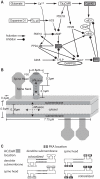
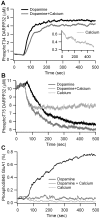
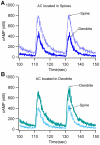
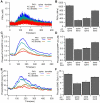


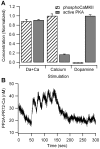

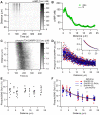
Similar articles
-
Colocalization of protein kinase A with adenylyl cyclase enhances protein kinase A activity during induction of long-lasting long-term-potentiation.PLoS Comput Biol. 2011 Jun;7(6):e1002084. doi: 10.1371/journal.pcbi.1002084. Epub 2011 Jun 30. PLoS Comput Biol. 2011. PMID: 21738458 Free PMC article.
-
Transient calcium and dopamine increase PKA activity and DARPP-32 phosphorylation.PLoS Comput Biol. 2006 Sep 8;2(9):e119. doi: 10.1371/journal.pcbi.0020119. PLoS Comput Biol. 2006. PMID: 16965177 Free PMC article.
-
A kinetic model of dopamine- and calcium-dependent striatal synaptic plasticity.PLoS Comput Biol. 2010 Feb 12;6(2):e1000670. doi: 10.1371/journal.pcbi.1000670. PLoS Comput Biol. 2010. PMID: 20169176 Free PMC article.
-
Regulation of neuronal PKA signaling through AKAP targeting dynamics.Eur J Cell Biol. 2006 Jul;85(7):627-33. doi: 10.1016/j.ejcb.2006.01.010. Epub 2006 Feb 28. Eur J Cell Biol. 2006. PMID: 16504338 Review.
-
Postsynaptic integration of glutamatergic and dopaminergic signals in the striatum.Prog Neurobiol. 1994 Oct;44(2):163-96. doi: 10.1016/0301-0082(94)90037-x. Prog Neurobiol. 1994. PMID: 7831476 Review.
Cited by
-
Computational investigation of the dynamic control of cAMP signaling by PDE4 isoform types.Biophys J. 2022 Jul 19;121(14):2693-2711. doi: 10.1016/j.bpj.2022.06.019. Epub 2022 Jun 18. Biophys J. 2022. PMID: 35717559 Free PMC article.
-
A stochastic model of hippocampal synaptic plasticity with geometrical readout of enzyme dynamics.Elife. 2023 Aug 17;12:e80152. doi: 10.7554/eLife.80152. Elife. 2023. PMID: 37589251 Free PMC article.
-
Spatial organization of adenylyl cyclase and its impact on dopamine signaling in neurons.Nat Commun. 2024 Sep 27;15(1):8297. doi: 10.1038/s41467-024-52575-0. Nat Commun. 2024. PMID: 39333071 Free PMC article.
-
Spatial distribution of DARPP-32 in dendritic spines.PLoS One. 2013 Sep 10;8(9):e75155. doi: 10.1371/journal.pone.0075155. eCollection 2013. PLoS One. 2013. PMID: 24058659 Free PMC article.
-
ERK regulation of phosphodiesterase 4 enhances dopamine-stimulated AMPA receptor membrane insertion.Proc Natl Acad Sci U S A. 2013 Sep 17;110(38):15437-42. doi: 10.1073/pnas.1311783110. Epub 2013 Aug 28. Proc Natl Acad Sci U S A. 2013. PMID: 23986500 Free PMC article.
References
-
- Hiroi N, Fienberg AA, Haile CN, Alburges M, Hanson GR, et al. Neuronal and behavioural abnormalities in striatal function in DARPP-32-mutant mice. Eur J Neurosci. 1999;11:1114–1118. - PubMed
-
- Yin HH, Ostlund SB, Knowlton BJ, Balleine BW. The role of the dorsomedial striatum in instrumental conditioning. Eur J Neurosci. 2005;22:513–523. - PubMed
-
- Cromwell HC, Hassani OK, Schultz W. Relative reward processing in primate striatum. Exp Brain Res. 2005;162:520–525. - PubMed
Publication types
MeSH terms
Substances
Grants and funding
LinkOut - more resources
Full Text Sources
Molecular Biology Databases

